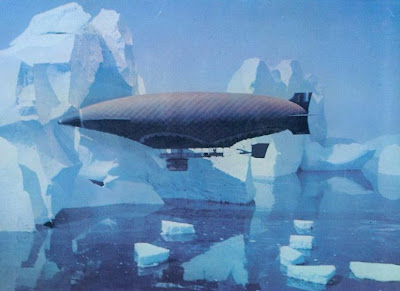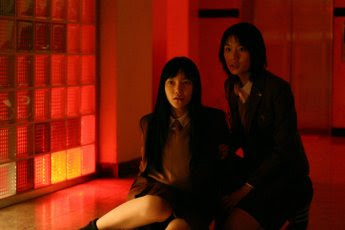THE ISLAND AT THE TOP OF THE WORLD
(1974, USA)
A British adventurer (Donald Sinden) sets off in search of his son, lost on an Arctic expedition. He enlists the help of an American expert in ancient civilisations (David Hartman) and a French pilot (Jacques Marin) who can quickly take them over the frozen wasteland in a huge airship. They're expecting a dangerous trip, but not a lost civilisation living above the Arctic circle...
This is adapted from the novel 'The Lost Ones', written by Ian Cameron. Wikipedia reveals that this is a pen name for Donald G. Payne, who also wrote as James Vance Marshall. His novel 'The Children' was filmed by Nicolas Roeg as Walkabout (1971), starring Jenny Agutter. As Ian Cameron he also wrote a sequel to 'The Lost Ones' called 'The Mountains At The Bottom of the World'.
The script for Island at the Top of the World is credited to John Whedon. The name looked suspiciously familiar and, sure enough, it's Joss Whedon's grandad. Currently basking in the success of Cabin in the Woods and Avengers Assemble, I hadn't realised that Joss Whedon's dad and grandad were both screenwriters...
As a child in the 1960s and a young teenager in the early 1970s, I soon decided that Walt Disney's animated films were too immature for me. I was already enjoying the violent, flashy adult fantasies of the Sean Connery James Bond movies by the age of ten. Back then, Disney's publicity was aimed squarely at young children with friendly, unthreatening, simplified poster art which severely undersold their classic animated re-releases.
I'd still go and see the live-action Disney films if it was a slow week, like The World's Greatest Athlete or The Love Bug, as long as the cast hadn't any annoying children in the cast (when's the last time you saw a children's film with only adult characters?). But when The Island at the Top of the World arrived, it was a must-see for me, promising spectacular adventure with some lengthy, action-packed clips on a couple of episodes of Disney Time.
In the early 1970s, there was a continued enthusiasm for 'lost world' adventures, set around 100 years ago, where adventure was found in unlikely places around the world, or under its surface. Ray Harryhausen's films had dominated this genre with Sinbad's adventures, Mysterious Island and many others, but Britain's Amicus studios had started adapting Edgar Rice Burroughs novels with unconvincing men-in-rubber suit dinosaurs (which I still wanted to see!). But here, Disney threw a hefty budget and superior visual effects at this Jules Verne-inspired variant, which was less far-fetched than most, but more spectacular.
While I baulk at recommending The Land That Time Forgot (though I may yet attempt to), Island stands up far better today. Indeed it compares favourably to two other airship dramas of that decade - The Hindenburg (1975) and Zeppelin (1971), which offer little besides a trip in an inflammable balloon.
Some of the visual effects have obviously dated, particularly the blue-screen compositing of live-action with model work. But the large-scale miniatures, huge functional sets (extended by many beautiful matte paintings) stand up pretty well. The briefly-glimpsed full-size animatronic killer whales are still superb, (just) predating good old 'Bruce' from Jaws, who surfaced the following year. But these look more realistic because of the shiny skins of their real-life counterparts. I honestly thought they were real at the time I saw this on first release (in the UK in January 1975).
 |
| David Hartman, Donald Sinden and David Gwillim |
Besides the engaging storyline, whose research into ancient societies and animal behaviour still stands up well today, the cast are just as much fun. There's all-purpose Asian Mako (the voice of Aku for Samurai Jack), a Japanese actor portraying an Eskimo. David Hartman, another likable American actor, is convincingly stoic and knowledgeable. I've not seen him in anything else but understand he was something on US television. Great voice! My favourite though is Donald Sinden, a well-known British actor, mainly known for his sitcom work, but here proving his worth as an eccentric adventurer, fearless, fallible and indignant that the rest of the world doesn't speak decent English. He's great fun throughout and I'm at a loss why he didn't get more leading roles, if only in Disney comedies.
I watched the UK DVD (above) which is presented in 1.85 widescreen anamorphic. It's good enough, but I'd still like to see a project of this scale treated with a Blu-ray.
The beautifully-designed airship 'Hyperion' from the film has actually been recreated in quite a large-scale as the centrepiece restaurant of Discoveryland in Disneyland Paris. I was surprised to see it when visiting the park when it first opened as EuroDisney in Easter, 1992, and I trust it's still there.





























